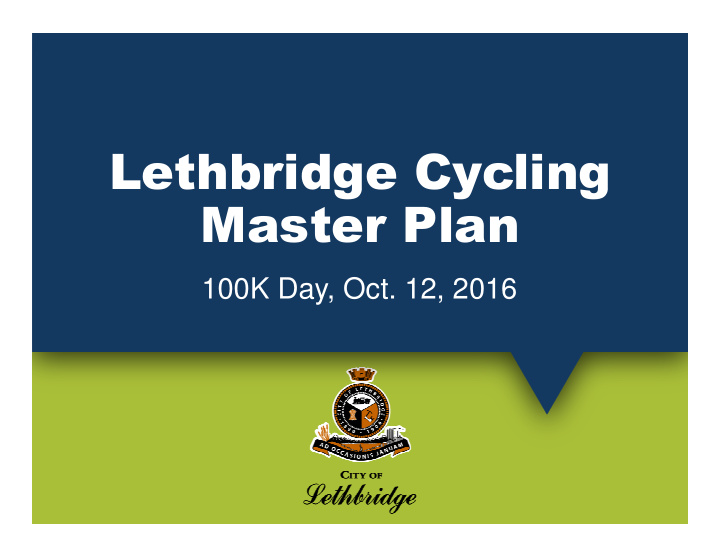



������������������� ����������� 100K Day, Oct. 12, 2016
Project Objective • Develop a master plan to create a safe and efficient cycling network in Lethbridge
Context • ICSP/MDP 2010 • TMP 2013 • Bikeways and Pathways Master Plan 2007 • Bike/Pathways Design and Construction Standards • CIP Projects • Development Applications
Project Overview Community Project Goals & Student Stakeholder Analysis Engagement Initiation Vision Feedback Meeting #1 #1 Community Refine Stakeholder Desire Opportunity Draft Engagement Draft Meeting #2 Lines Corridors Network #2 Network Today Community Final Implementation Engagement Report Strategy #3
Vision and Goals • A project vision and set of goals to guide the project were established early on: • Cycling is Safe • Cycling is Connected • Cycling is Understood • Cycling is Desirable • Cycling is Implemented • More People Cycling
Analysis • Telephone survey • Cycling demand analysis • Cycling potential analysis • Cycling collision analysis • Community input maps
Student Feedback • University of Lethbridge and Lethbridge College students were engaged. • Where do you bike? • Share your ideas • Provide feedback on goals and vision • What are your challenges? • What are the benefits of cycling?
Stakeholder & Community Engagement #1 • Presented and ranked Vision and Goals • Presented telephone survey summary, collision map, and cycling analysis • Community input maps developed • Presentation by North American cycling expert • Feedback collected
Desire Lines • High level view of where people want to get to and from • Developed from analysis and origin / destination maps
Opportunity Corridors • Opportunity Corridors represent where desire lines line up with actual streets
Stakeholder Engagement #2 • Shared opportunity corridors • Discussion on the benefits, trade-offs and constraints of various types of cycling infrastructure • Discussed route selection evaluation criteria • Mapping exercise
Develop Draft Network • A draft cycling network was developed for presentation at Community Engagement #2
Community Engagement #2 • Presented draft network • Asked for specific feedback on infrastructure types, preferred routes and implementation preferences
Refined Draft Network • Based on internal and external feedback received to date • Cycling infrastructure types were selected based on a combination of public feedback and best practices • The network is ready for a final review and comments
Implementation Strategy • Each route was assessed using the implementation criteria
Implementation Criteria � � Constructability Cycling Demand and Generators The feasibility of construction of routes and any potential The existing and future opportunities there are in ridership that could be existing/future plans or anticipated and how the route development opportunities serves key destinations � � Cost Cycling Potential The high level anticipated Ability of route to support capital cost for high levels of cycling based implementation on characteristics of the � natural and built Community Acceptance environments The anticipated level of � Network Connectivity acceptance of the community to the changes required in To what extent does the route order to implement the routes contribute to filling a gap within the City’s cycling network
Implementation Strategy • Criteria used to determine which routes are proposed in the short, mid and long terms. �������� ������� � ��������������� � �������� �������������� � ������������� �������� � ������������ ������� ������� � � �������� �������
Implementation Strategy • Implementation criteria reflect the Goals of the project ����� ��������������� �������� ������������ ������� � ������������������ ��������� ����������� � ���� ����������������� � ����������������!��� ����������� ������#�� � ������"���#����� ����������� ��������� � ���� ����������� � ����"�����$��������� %��������� ����������� &����������
Phase 1 Network ($10M)
Phase 2 Network ($5M)
Phase 3 Network ($7M)
Next Steps • Receive final comments from public • cyclelethbridge.mindmixer.com • www.lethbridge.ca/cyclingplan • Compile final report by end of 2016
Recommend
More recommend